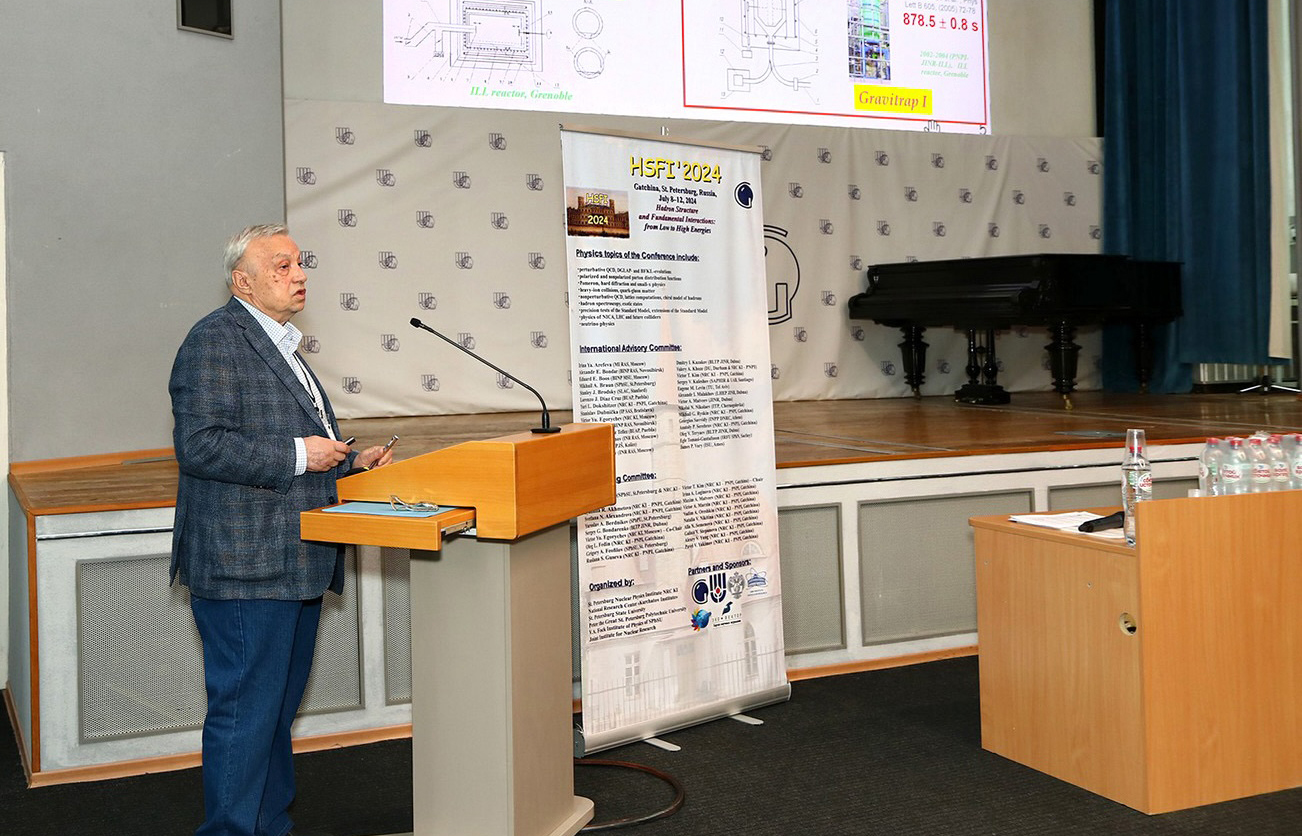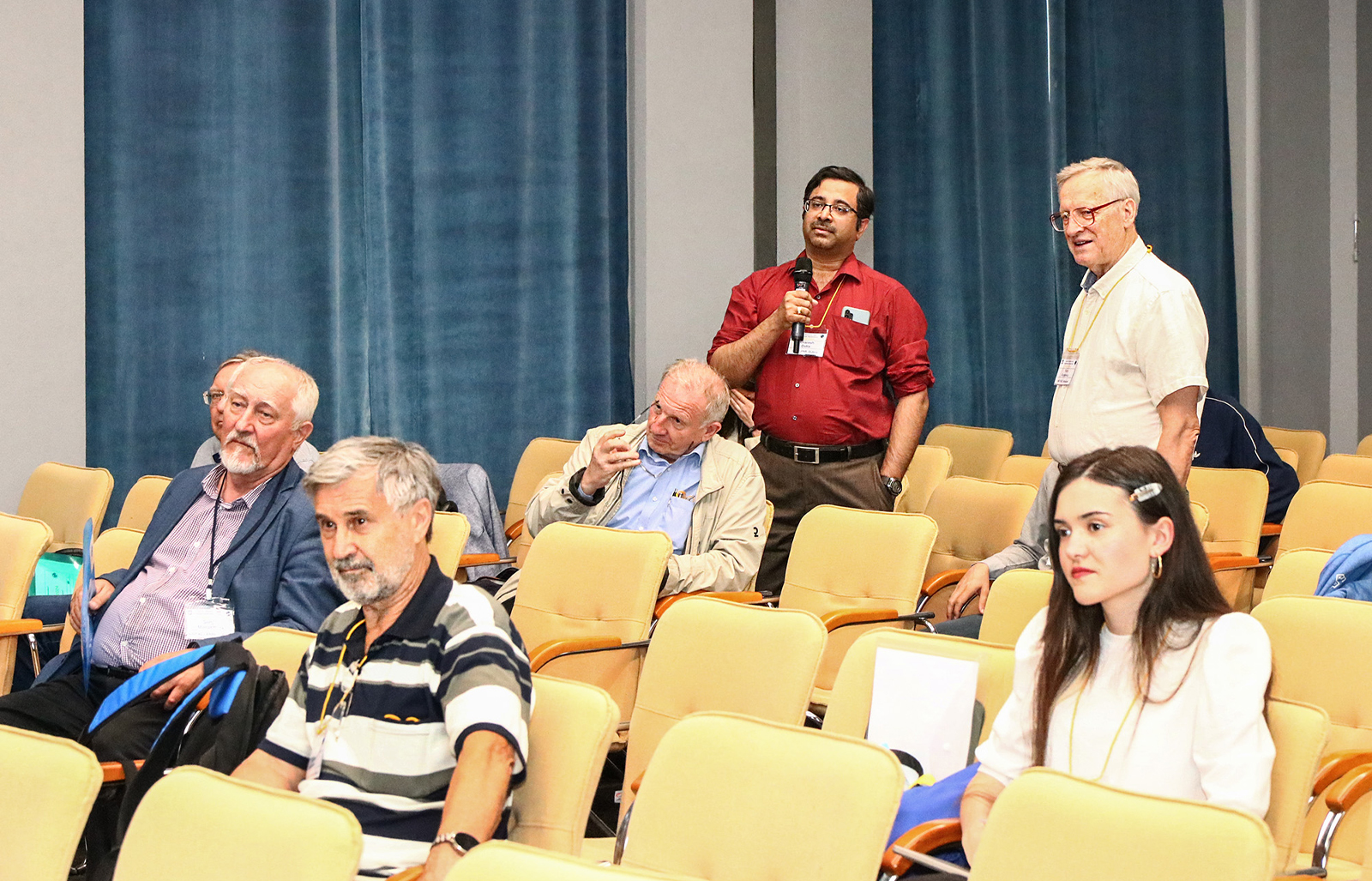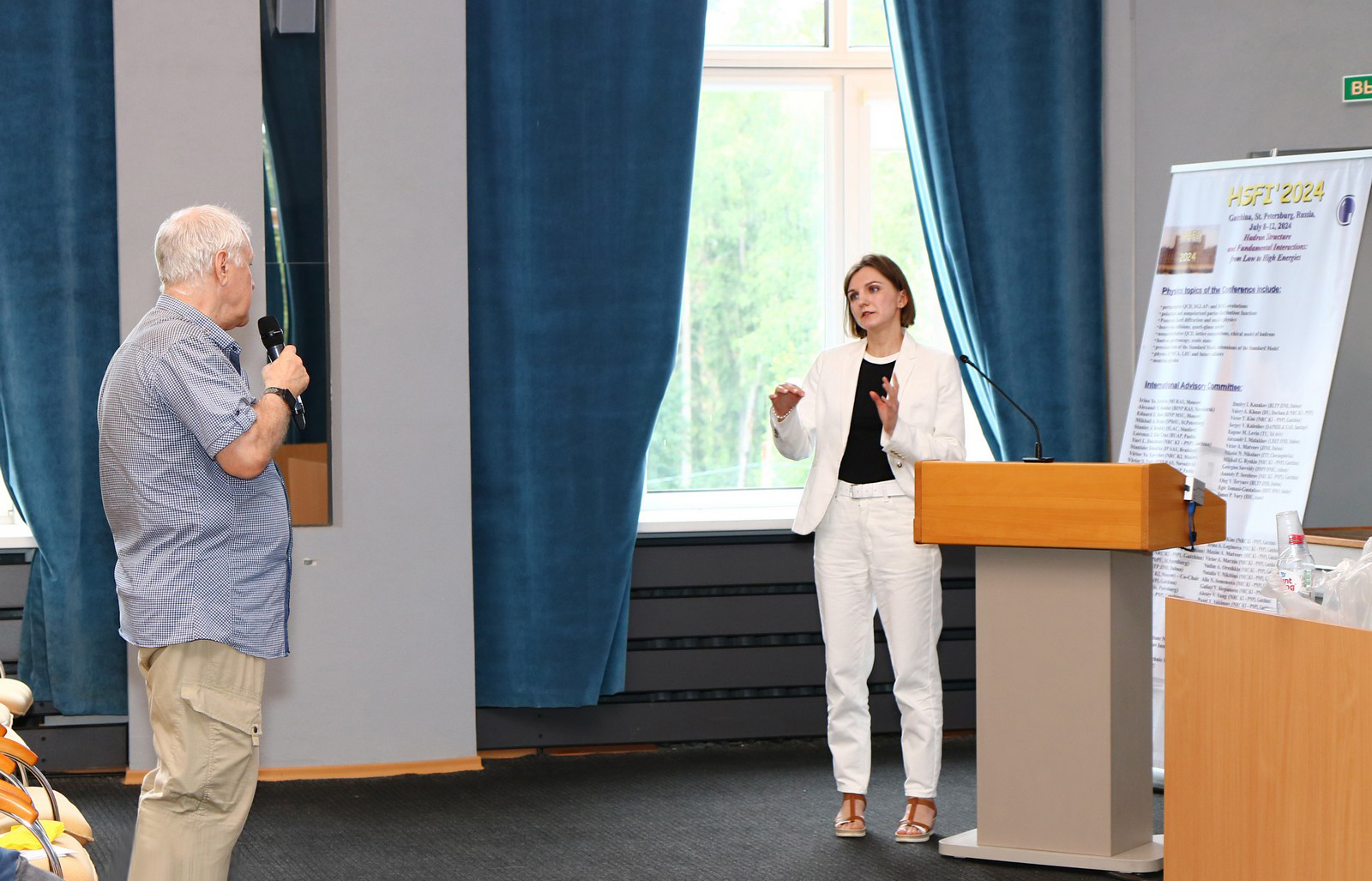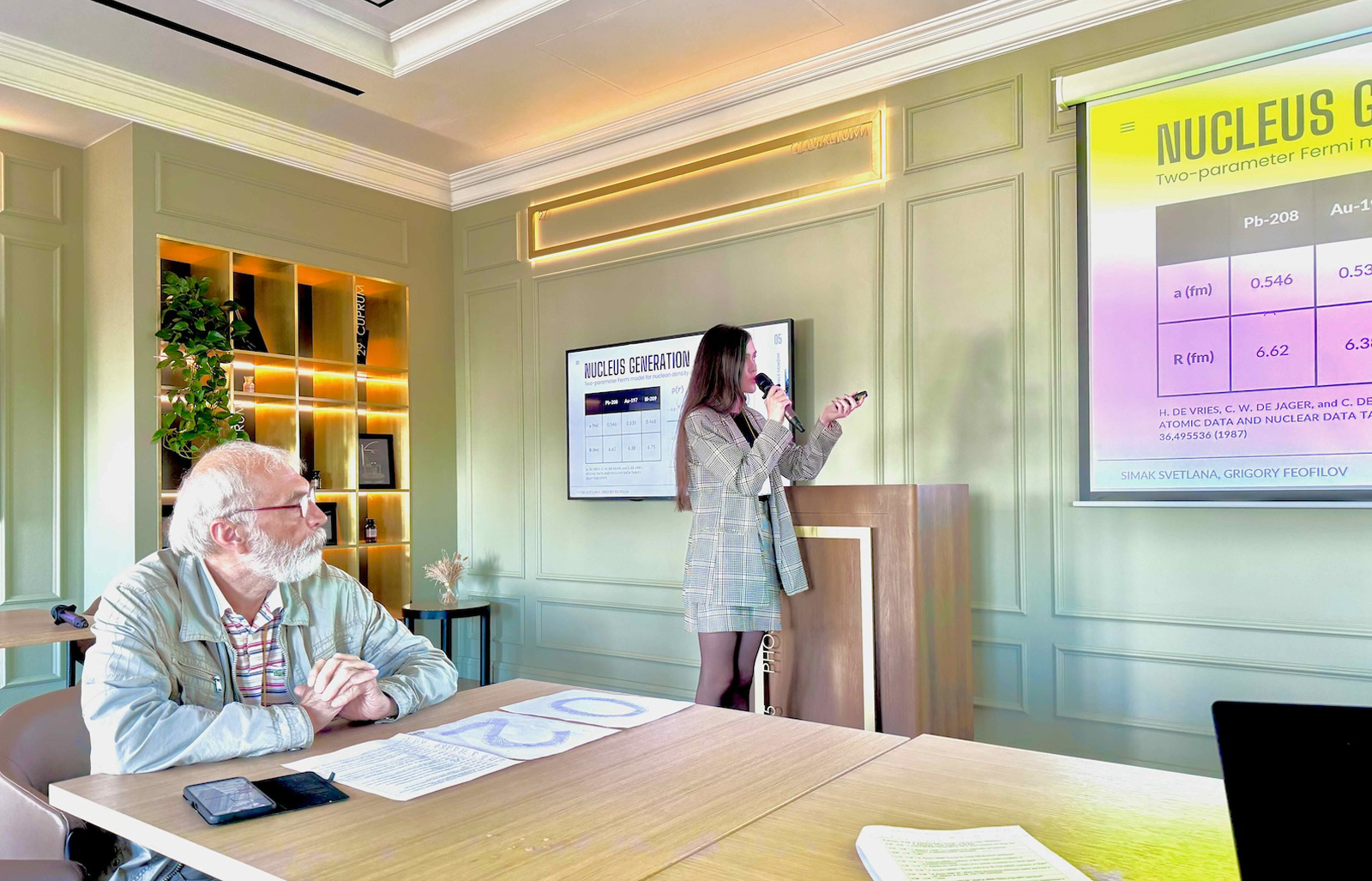9th International Conference on Hadron Structure and Fundamental Interactions finishes
News, 22 July 2024
On 8-12 July 2024, Konstantinov Petersburg Nuclear Physics Institute (PNPI) of the Kurchatov Institute National Research Centre (KI NRC) hosted the 9th International Conference on Hadron Structure and Fundamental Interactions (HSFI-2024). PNPI, Saint Petersburg State University (SPbSU), Peter the Great St. Petersburg Polytechnic University (SPbPU), SPbSU Fock Institute of Physics, and the Joint Institute for Nuclear Research organized the event.
The conference aimed to review and discuss progress in theoretical and experimental hadron physics, quantum chromodynamics (QCD), neutrino physics, the Standard Model and its extensions. Another important topic is the latest experimental achievements at the Large Hadron Collider (LHC) at CERN (Geneva, Switzerland), at the NICA Collider soon to be launched at JINR, and in other world centres of low, intermediate, high energy, and nuclear physics.
The event featured reports by the world’s leading scientists on various topical issues and tasks of high energy physics. Active discussions took place regarding progress in theoretical and experimental research into the inclusive interaction of leptons with polarised and non-polarised targets, the study of hadron structure and exotic states, the development and use of perturbative and non-perturbative QCD methods, the physics of the Higgs boson, heavy quarks, exotic quark states, neutrino physics, and many other aspects of strong interactions, the Standard Model, and new physics beyond it.
More than 80 scientists, postgraduates, and students from Australia, China, India, Italy, Kazakhstan, Russia, South Korea, Syria, and the USA attended the conference. The participants represented PNPI (Gatchina), KI NRC (Moscow), KI NRC Institute for High Energy Physics (KI NRC IHEP, Protvino), SPbSU and SPbPU (St. Petersburg), Skobeltsyn Institute of Nuclear Physics of Moscow State University (SINP MSU, Moscow), JINR (Dubna), Novosibirsk State University (Novosibirsk), Samara State University (Samara), Moscow Institute of Physics and Technology (Moscow), the Institute for Nuclear Research of the Russian Academy of Sciences (INR RAS, Moscow), the Institute of Nuclear Physics of the RAS Siberian Branch (INP SB RAS, Novosibirsk), RAS Steklov Mathematical Institute (Moscow), and the Institute of Nuclear Physics of the Republic of Kazakhstan (INP RK, Almaty, Kazakhstan). Attendees from the University of Calabria (Rende, Italy), Macquarie University (Sydney, Australia), Shandong University of Science and Technology (Qingdao, China), the University of Montenegro (Podgorica, Montenegro), the George Washington University (Washington, USA), and SLAC National Accelerator Laboratory (Stanford, USA) delivered their presentations remotely. JINR had the largest number of delegates, including five participants from BLTP, nine from VBLHEP, and one from DLNP.
The conference started with a report by RAS Corresponding Member Anatolii Serebrov (PNPI), which attracted great attention of the audience. The talk was devoted to the analysis of the NEUTRINO-4 Experiment results supporting the hypothesis that the manifestation of sterile neutrinos is an indication of the existence of right-handed vector bosons, i. e. mirror particles of the extended Standard Model, which could be the dark matter of the universe. An overview by Yury Kudenko (INR RAS) discussed general issues of neutrino physics and current and planned experiments: NEUTRINO-4 (PNPI), DANSS (KI NRC, JINR), BEST (INR RAS), Baikal-GVD (JINR, INR RAS), T2HK (Japan), Daya Bay and JUNO (China), RENO (South Korea), IceCube, DUNE, NOVA (USA), etc.
The results of the NA64 Experiment at the SPS (Super Proton Synchrotron) at CERN to search for particles beyond the Standard Model in the light sector, which could be the dark matter particles, were presented in a report by Dmitry Kirpichnikov (INR RAS) and Dmitry Peshekhonov (VBLHEP JINR).
Vladimir Voronin (PNPI) talked about an interesting approach to searching for manifestations of new physics beyond the Standard Model in nucleon-nucleon interactions using neutron scattering. Victor Ezhov (PNPI) reviewed the prospects of precision neutron lifetime measurement, which affects the accuracy of determining the matter-antimatter asymmetry of the universe.
As shown in the report by Victor Kim (PNPI), the naturalness domain of the Standard Model, determined by the evolution of the Higgs boson mass, extends to a wider range of energies than previously thought, so the LHC energy may not be enough to see new dynamics of the Standard Model or manifestations of the new physics beyond it.
RAS Corresponding Member Alexander Belavin (RAS Landau Institute for Theoretical Physics (ITP RAS), Chernogolovka) spoke about new ideas for compactification of multidimensional superstrings to our four-dimensional space, with a possible justification for the existence of dark matter in the universe. Ian Nagle (Macquarie University, Australia) reported on black hole thermodynamics and the horizon problem.
The conference featured the leading high energy physics experimental collaborations at the Large Hadron Collider (LHC) at CERN: ATLAS, CMS, LHCb, and ALICE. New LHC data on the physics of the Higgs boson, a refinement of the Standard Model, and the search for new physics were discussed. In particular, Yuri Naryshkin (PNPI) delivered a report on the ATLAS result on the first measurement of quantum entanglement in the formation of top quarks.
Alexey Dzyuba (PNPI) and Daria Savrina (KI NRC, SINP MSU) reviewed the latest results of the LHCb Experiment. The audience expressed great interest in the recently discovered pentaquark and tetraquark resonances with charm quarks and the observation of the possible non-universality of electron and muon interactions in the same experiment. Possible deviations from the predictions of the Standard Model were reviewed by Aidos Issadykov (BLTP JINR, INP RK).
The report by Igor Strakovsky (George Washington University) was devoted to the mystery of the lack of formation of pentaquark resonances with charm quarks both in experiments at JLAB (Newport News, USA) and at BELLE at KEKB, which currently raises a question regarding the existence and properties of pentaquark exotics.
Andrei Sarantsev (PNPI) discussed the status of hadron spectroscopy and exotica in the light sector in a review report. Yury Khokhlov and Valery Dorofeev (IHEP) made a presentation on indications of the manifestations of exotic states with multiquark and glueball properties in the VES Experiment at the U70 Accelerator at IHEP (Protvino). Andrey Zelenov (PNPI) talked about predictions in the diquark approach for the formation of exotic hadron states of tetraquarks.
Curious results on the hadron formation dynamics requiring a non-trivial explanation were presented from the alma mater of collider physics, INP SB RAS (Novosibirsk), by the SND (Vladimir Druzhinin, Alexey Kharlamov), KMD-3 (Evgeny Solodov), and KEDR (Tatyana Kharlamova) Collaborations at the e+e- VEPP-2000 Collider.
The physics programme of the SPD Experiment for the stage of high-intensity polarised and non-polarised proton-proton and deuteron-deuteron collisions at the NICA Collider at JINR was outlined in the report by Amaresh Datta (DLNP JINR). Tianbo Liu (Shandong University of Science and Technology) talked about physics at the electron-ion collider under construction in China. This facility, along with a similar accelerator being constructed in the USA, will be a source of physics results complementing the polarised physics studied at NICA. Boris Ermolaev (RAS Ioffe Institute) proposed a way to resolve the proton spin crisis observed in experiments with polarised beams.
On 10 July, SPbSU Mendeleev Conference Centre hosted the HSFI-2024 sessions on physics of ultrarelativistic nuclei collisions. At the beginning of the morning session, RAS Corresponding Member Irina Arefeva reported on interesting ideas based on the holographic approach to the study of QCD/AdS duality for physics of heavy nuclei collisions at high energies.
VBLHEP JINR employees Alexander Malakhov and Mikhail Tokarev made a report on non-traditional approaches to multiple hadron production.
SPbSU researchers Vladimir Vechernin, Vladimir Kovalenko, Evgeny Andronov, Daria Prokhorova, and others represented the scientific school of Mikhail A. Braun. The scientists reported on their efforts to develop the approach he developed, reviewing the diverse effects for the observed quantities in the multiple hadron production at high energies, such as the fusion of colour strings at high density, etc.
Another topic for discussion that day was the recent results on heavy ion beams by the NA61/SHINE Experiment at the SPS at CERN and by the SPbSU and BM@N team at the Nuclotron at JINR reviewed by Vasilii Plotnikov, Vadim Kolesnikov, and Mikhail Mamaev from VBLHEP at JINR. On behalf of the CMS Collaboration, Dmitry Sosnov (PNPI) delivered a report about the first LHC measurement of diffractive proton-nuclear collisions. For the first time, it was demonstrated that electromagnetic contribution can dominate the contribution of strong interactions in ultrahigh energy diffractive processes in experiments with heavy nuclei.
Special attention was drawn to the presentation by MPD Collaboration Leader Victor Riabov (PNPI, VBLHEP JINR) on the status and prospects of the initial work stage at the soon to be commissioned NICA Collider at JINR designed for relativistic nuclei collisions. The talk by Dmitry Ivanishchev (PNPI, SPbPU) was devoted to the measurements planned at the MPD’s first stage.
As usual, one of the central topics of the conference was the issues of high-energy QCD, discussed in the reports by RAS Corresponding Member Victor Fadin (INP SB RAS), Alessandro Papa (University of Calabria), Natasha Raicevic (University of Montenegro), and Alexey Chernyshev (SamSU). Victor Kim (PNPI) spoke about the manifestations of the Balitsky-Fadin-Kuraev-Lipatov (BFKL) evolution of high-energy QCD asymptotics. Vadim Oreshkin (PNPI) presented recent CMS measurements on dijet events with a large separation in speed showing a significant contribution of BFKL evolution, the first direct manifestation of BFKL asymptotics.
Theoretical aspects of non-perturbative QCD and progress in lattice approaches were discussed by Yonggoo Heo (VBLHEP JINR), Ilya Kudrov (IHEP), and Roman Zhokhov (IHEP, IZMIRAN).
Anatoly Kotikov (BLTP JINR) and Andrei Kataev (INR RAS) talked about the results of perturbative QCD for deep inelastic scattering. The results of QCD on the light front were presented in the review by Stanley Brodsky (SLAC) and in the report by Mikhail Malyshev (PNPI).
The conference successfully continues the traditions started by the Leningrad Nuclear Physics Institute of the USSR Academy of Sciences during International Symposiums on Nucleon-Nucleon and Nucleon-Nuclear Interactions at Intermediate Energies, All-Union Conferences on High-Energy Interactions in the 80s, International Conferences on Perturbative QCD Physics (1989), Physics at Light Cone and Small x (1998), the Equations of DGLAP and BFKL Evolutions (2000), Physics of Deep Inelastic Scattering (DIS-2003), and LHC physics (LHCP-2015). This series of conferences began in 2004. The series of conferences on the structure of hadrons and quantum chromodynamics HSQCD has long been informally called Lipatov Conferences, commemorating its main organizer, RAS Academician Lev Lipatov (02/05/1940 – 04/09/2017), an outstanding Russian scientist, the author of many highly influential works on high energy processes in quantum field theory, quantum electrodynamics, quantum chromodynamics, and quantum gravity. The HSQCD’2018 conference was held in memory of Academician Lipatov.
The QCD issues, a topic in which Soviet and Russian researchers have always been prominent, are a key focus of the conference. At high energies, the key property is the factorisation of long and small distance contributions (Anatoly Efremov and Anatoly Radyushkin from BLTP JINR), where the evolution of non-perturbative parton distributions is described by the Dokshitzer-Gribov-Lipatov-Altarelli-Parisi (DGLAP) and BFKL equations, and the contribution of small distances is calculated according to perturbation theory (Alexey Vladimirov, Dmitry Kazakov, Anatoly Kotikov, Sergey Gorishny (BLTP JINR), Fedor Tkachev, Konstantin Chetyrkin, Sergey Larin, Andrei Kataev (INR RAS), etс.). The works by Anatoly Efremov, Oleg Teryaev (BLTP JINR), Lev Lipatov, Andrey Bukhvostov, Gleb Frolov (PNPI), and Eduard Kuraev (BLTP JINR, INP SB RAS) played an important role in describing polarised processes in QCD. For non-pertubative study, the most important were the method of QCD sum rules (Arkady Weinstein from INP SB RAS, Mikhail Shifman, Valentin Zakharov from KI NRC Institute for Theoretical and Experimental Physics) and the discovery of instantons (Alexander Belavin, Alexander Polyakov, Yuri Tyupkin from ITP RAS, Albert Schwartz from MEPhI).
What consistently attracts interest to the conference are the talks on notable scientific results and pioneer studies by employees of the PNPI Department of Theoretical Physics (with Vladimir Gribov, Vladimir Shechter, Igor Dyatlov, Alexey Anselm, and Lev Lipatov playing a leading role in 1960-2017), which formed the basis for the theory of strong interactions at high energies. Another highlight is the significant participation of researchers of JINR, leading RAS institutes, the Russian universities, and Kurchatov Institute, namely the PNPI Department of High Energy Physics (under the leadership of Alexey Vorobyov from 1970 to 2021) in the world’s leading experimental projects.






